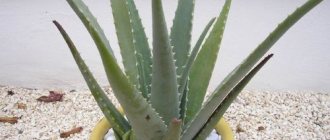Pedilanthus is a unique tropical plant that can win the heart of the most sophisticated gardener. This will be facilitated by the brightness of the bracts and the original variegation of the leaves. In addition, the home flower is unpretentious in care and tolerates high temperatures well. However, there are a number of rules that must be followed, otherwise the plant will die.
Pedilanthus came to our homes from the distant shores of North and South America. It can also be found in Mexico. The name of the flower consists of two Greek words - shoe (pedilon) and flower (anthos). It received this name due to its bract, which has an unusual shape. The flowers of the plant are often united in an umbrella-shaped inflorescence.
The diameter of the flower stem can reach 1 centimeter, and the flower can grow up to 2 meters in height. The stem is powerful and fleshy. With each new leaf appearing, the stem takes on a stepped shape. In addition to their white-green color, the leaves have a waxy coating that protects them from heat.
How does Pedilanthus grow?
Pedilanthus has the shape of a bush, and its stems do not branch at the bottom. The formation of the crown and lateral branches is observed in the upper part of the shoots. For planting, it is recommended to use a light soil mixture.
Interesting materials:
How to use the remote control on Xiaomi? How to use Xiaomi selfie stick? How to use a paper clip? How to use wax and seal? How to use the DPD terminal? How to use a USB modem? How to change ava in a contact from an album? How to change the battery of iPhone 5s? How to change a disc on an angle grinder with a key? How to change the background image?
Diseases and pests
- The leaves of pedilanthus turn pink - this is a normal phenomenon, the leaves begin to turn pink when the plant is exposed to the sun for a long time, but they never become completely pink, only the border. This is their feature, their variegated form.
- Leaves are falling, what should you do - if the leaves begin to fall off during the dormant period, then the norm is a leaf drop of up to 50%, but if this happens during active growth in spring or summer, it means that the plant’s conditions are not suitable.
- Drops leaves - the reason may be stagnation of moisture in the pot or drying out of the soil. Also a disadvantage, or vice versa, is exposure to direct sunlight on the plant.
- Why do the leaves turn red - this is also a slight natural process, from bright lighting, but they do not become exactly red, but more of a scarlet hue.
- Spider mites, aphids and whiteflies can pose a danger to the plant - to combat them it is necessary to treat the plant with insecticides.
I liked the article! Rate it.
Questions have arisen regarding cultivation! Write in the comments.
Botanical description of the plant
About 15 species of the genus Pedilanthus are found in nature. Only a few varieties are grown in indoor floriculture, which will be discussed below.
An evergreen bush with straight stems directed straight up. The stems are thick, fleshy, with little branching, round or flat in shape, pale green or grayish in color. They are covered with a waxy substance.
There are no leaves. Instead, small scaly growths are located along the entire length of the stems. During the flowering period, pedilanthus large-fruited resembles a candle in appearance: straight, bare stems are crowned with red or orange lancet buds.
The shape of the flowers is typical of all pedilanthus: they are tiny glossy “shoes”. Pedilanthus largefruited is native to the arid Mexican deserts. Thanks to its succulent properties, it is able to accumulate moisture and easily tolerate short-term dryness.
Some varieties of pedilanthus have completely green leaves.
In indoor floriculture this is the most common type. It is unpretentious, does not require special care, reproduces well, and thanks to the interesting color of the leaves and the zigzag shape of the stems, it has high decorative properties.
At home, pedilanthus titimaloides is grown as a bush. It is reluctant to branch, so to achieve decorativeness, 3-5 plants are planted in a pot.
The leaves are shiny, elongated, with a pointed tip, and are basically green.
For reference! Variegated varieties of pedilanthus have a white, cream or pinkish border on the leaf blades. With proper care, small red “shoe” inflorescences appear on the tops of the stems in late autumn.
The stems are zigzag-shaped, long, strong and elastic, bare along the entire length. Finki's pedilanthus leaves are present only at the tops of the stems. The color of the leaf blades of most varieties is green, with a uniform color. The shape is pointed, elongated with a characteristic waxy coating.
Attention! Many have not even seen pedilanthus bloom, because it is extremely difficult to achieve this at home. To stimulate flowering, the temperature in the room in winter should be 14-18 degrees, which is practically impossible at home.
Pedilanthus is a rather unusual plant, the appearance of which resembles artificial flowers made of plastic. However, it exists, lives and pleases its owners with its beautiful appearance. This succulent with its foliage is similar to some types of ficus (for example, Ficus Benjamin). The name of the plant comes from the shape of its flowers: in Greek pedilon means “slipper” and anthos means “flower”.
READ MORE: How to prune Kalanchoe depending on the variety - step-by-step instructions with photographs
The genus Pedilanthus contains 15 subspecies, each of which is original in its own way - there are shrubby, succulent and herbaceous forms. What unites them is only the milky sap that flows through the stems of plants.
Like other indoor flowers, pedilanthus is associated with folk beliefs that force indoor gardeners to grow this plant at home or abandon it altogether.
For example, buying a bush or secretly plucking a cutting in a public place can lead to improved social status, professional growth, or a change in job to a better and more prestigious one.
Pedilanthus, like every succulent, thrives in conditions that at least somewhat replicate tropical ones. On sunny but shaded windowsills, or in a summer garden in the shade of trees, it will delight you with its lush growth and colorful flowering.
The flower is credited with the ability to attract good luck in career advancement, perhaps due to its popular name "Jacob's Ladder". Be that as it may, the sign applies only to the donated plant. However, there are exceptions to this rule. The flower is considered a muzhegon, so it is not worth purchasing and giving it to single girls and women who want to find a partner in life.
Other signs:
- If married women are in danger of breaking up their marriage, it is also better for them to refrain from cultivating the “devil’s backbone”.
- Another sign relates to the well-being of the plant. If it sheds its leaves not before the dormant season or completely withers, one of the household members may get sick.
- The absence of flowering indicates that the harmony of relationships in the family is disturbed.
- If the plant begins to tilt and its growth ceases to be vertical, someone’s professional career in the family will decline.
- The stem began to lengthen and the leaves began to lighten—parting ahead.
- The tips of the leaves dry out - you should be afraid of colds.
- Roots rot - there is a high probability of an accident.
Of course, you can attach importance to these signs, and yet they can be fully explained by a violation of the rules of agricultural technology and corrected by correct correction.
Lighting
Pedilanthus needs bright, but diffused light. In summer, the optimal place for a flower will be a western or eastern window .
The plant must be shaded from the scorching rays of the sun, otherwise the leaves may burn.
When it’s warm outside, the flower can be taken out to the balcony or veranda, having previously taken care of protection from precipitation and direct sun.
In winter, pedilanthus will do best in a south-facing window. At this time of year, it will need additional lighting using fluorescent or phytolamps.
Temperature
Like all succulents, pedilanthus tolerates heat well. During the active growth phase, the temperature in the room with the flower should be no lower than 22°C.
The optimal value is 26°C. The dormant period occurs in the winter months. At this time, the air temperature should be lower and be 15-17°C. Violation of the regime will lead to the fact that pedilanthus will not bloom next season.
It is forbidden to place the bush near the battery, as hot dry air can cause leaves to fall off. In addition, the plant needs regular ventilation.
Fertilizer
Pedilanthus is fed from spring to autumn once every 3-4 weeks. For this purpose, it is better to choose fertilizers for cacti and succulents. The concentration should be 2 times weaker than indicated on the package. In winter, fertilizing is not needed.
It is important to ensure that the fertilizer contains as little nitrogen as possible: its excess has a negative effect on pedulanthus.
It is recommended to alternate mineral fertilizers with organic ones. As the latter, you can use the dry part of mullein or its solution.
In a flower shop you can choose mineral fertilizers, for example, GreenWorld, Standart NPK, BonaForte, Pokon and others.
Possible difficulties:
* Leaves are falling off. This occurs due to a violation of the irrigation regime, due to a lack or excess of light.
* The plant stretches out in winter due to insufficient lighting and too warm conditions.
Pedilanthus titimaloides is a widespread bushy plant of Central and South America, as well as the Caribbean islands.
This species is most popular as an unpretentious houseplant. It has original shaped flowers, which are compared in shape either to a bird or to a slipper, as well as spectacular variegated foliage, the color of which varies from white at the edges of the leaf to dark green with white splashes in the middle. The plant is also characterized by a change in leaf color from white to pink.
The stem of the plant is also original - it changes direction every time it grows a leaf, resulting in a pronounced zigzag shape. Thanks to this feature, the natives call the plant Jacob's Ladder - Jacob's Ladder and Devil's Backbone - Devil's Backbone.
Pedilanthus titimaloides can be seen in many homes. It is considered an indoor decorative flower, which belongs to the family of euphorbia plants. Perhaps, due to the complex name of this plant, you did not know about its existence in your home. They brought him to the vast expanses of Central America, that is, the climate he was accustomed to was tropical. However, breeders were able to adapt this plant to almost any natural conditions, so today we can see it in the homes of people on various continents.
Reproduction
Pedilanthus propagates by cuttings. The optimal time for this is spring and summer. The tops of the shoots, 8-10 cm long, are cut off with a sharp knife. Propagation of pedilanthus by cuttings should be done with gloves, since the sap of the plant is poisonous and can cause a burn on the skin.
The cuttings are placed in water for several hours to remove the juice from them. Then they are planted in boxes filled with a mixture of sand and leaf soil in equal parts.
The containers are covered with film or glass and placed in a bright, warm (24-26 degrees) place.
After 2-4 weeks, when the young specimens have taken root, they are planted in individual pots of 3-4 pieces each (for greater lushness in the future).
Seeds
Having bought the seeds in the store, they are planted in pre-disinfected soil made from a large amount of sand and a small part of turf soil.
The seeds are slightly deepened and moistened, then covered with film . Crops need to be ventilated every day to protect them from rotting.
When the first sprouts appear, the container with them should be placed in a well-lit place. Be sure to shade if sunlight shines directly on them.
The film is removed when the sprouts are strong enough. Transplantation into separate pots is carried out a month after the shoots appear .
Transfer
If the flower grows well, it is periodically necessary to transplant the pedilanthus into a freer container. This process should occur in the spring during the formation of new leaves. The pot is selected to be approximately the same in width and height and slightly larger in volume than the previous one.
Transplantation should be carried out as soon as the root system grows to the size of the pot itself. In the first days after transplantation, the plant should be placed in a dark corner so that it can adapt.
After direct contact with the plant, you must wash your hands well with soap, as the plant emits a toxic liquid. It is best to wear rubber gloves. Pets and children should not be allowed to come into contact with this plant for the same reason.
Difficulties you may encounter
When growing a plant, you may encounter various problems. Leaves begin to fly off. Watering is not carried out correctly. Excess or deficiency of lighting. In the winter months, the stems begin to stretch. Poor lighting and the room temperature is not what it should be.
Long leaf petiole. This is normal.
The tips of the leaf blade began to turn yellow and dry out. Low level of air humidity, light intensity. Green leaves are small in size, instead of being large, variegated, and later they begin to fly around altogether - lack of lighting.
The leaves become green, the petioles stop developing - there is a lot of nitrogen in the soil.
The plant has dropped all its leaves. The air temperature was sharply reduced by ventilation in the winter. If the shoots managed not to freeze and retained their green color, then the plant will live. If not, then all those parts that have died must be pruned and you will need to wait for new shoots to appear.
Secrets of care
Since pedilanthus in nature is a small plant compared to other representatives of tropical flora, in the wild it does not get much sun. The plant prefers diffused light even in indoor conditions, but does not like direct sunlight.
Location
Placement: window sill facing east or west. If you place pedilanthus near a south window, it needs shading in the summer.
The plant loves fresh air, so in the summer, take the spurge with you to the dacha and place it in the garden, or put it on the balcony (taking care of protection from direct rays of the sun and precipitation).
If outdoor living is not possible, provide frequent ventilation.
In winter, if it is not possible to provide the plant with a full period of rest, you will have to additionally illuminate it with fluorescent lamps.
Air temperature
In spring and summer, pedilanthus needs a room temperature within +22...+25°C. In the fall, the temperature of the plant is reduced, bringing it to +14...+18°C (but not higher) in winter. If you manage to maintain the winter temperature regime, the plant will partially shed its leaves and get a good rest. During the period of central heating operation, it is not possible to find a room with the required temperature for pedilanthus.
But the plant will not become capricious and will endure the hot winter. More leaves will fall than in cool weather, and the color of the leaves will become paler, but in the spring the plant will recover and continue the growing season.
Subtleties of watering Pedilanthus
The main subtlety of watering pedilanthus is that this plant can live without water, like a cactus.
Frequent watering in winter is undesirable and even harmful to the plant. From November to March, if the temperature is maintained, one watering per month is enough for pedilanthus. If the temperature is higher than required, water once every two weeks. In spring and summer, the plant is watered more often, weekly or once every 10 days. Watering - with settled or softened water.
Problems with lack of moisture
Experienced gardeners focus on the appearance of pedilanthus. This spurge, like no other plant, can “show” the owner what he needs. As soon as the soil dries out, the leaves lose turgor and droop slightly. After watering they rise again.
If pedilanthus has dropped its leaves at the height of the growing season, it needs water urgently. Immerse the pot with the plant in a container of warm water for 15 minutes, then, after wetting the earthen lump, allow the excess water to drain.
Air humidity
A resident of the tropics, pedilanthus, however, tolerates dry air. Spraying is necessary for the plant only in summer (including when kept in the fresh air). In winter, even with central heating running, there is no need to spray pedilanthus.
Feeding
There are no difficulties with fertilizing for this plant. From spring until autumn, once a month, pedilanthus is fed with fertilizers for succulents and milkweeds.
Any fertilizer is suitable, but make sure that the nitrogen content is minimal. If you overfeed pedilanthus with nitrogen, the roots and then the stem will rot and the plant will die. During the dormant period, pedilanthus does not need feeding.
Pot and soil
The plant needs a light substrate, loose, permeable, capable of providing air access to the roots. The soil reaction is made neutral (in no case acidic). Store-bought soil for succulents and milkweeds meets these requirements. Add one part sand to three parts soil.
Pot sizes
The root ball of the plant is small, so the pot is chosen to be compact.
Use river sand (pre-calcinate it or spill it with a hot solution of potassium permanganate). If you are preparing soil for indoor plants yourself, mix leaf soil, turf soil and sand in a 2:1:2 ratio.
Replanting and pruning
Pedilanthus grows and develops roots slowly. Therefore, there is no need to regularly replant the plant. What it needs is to renew the top layer of soil. To do this, you need to remove two to three centimeters of soil in the pot and add fresh soil. This operation is performed every two months.
It's time to replant pedilanthus when the roots fill the pot and entwine the earthen ball. It is better to time the transplantation in the spring, or at least in the summer, but under no circumstances during the dormant period. The height of the pot is equal to the diameter. Be sure to put expanded clay or other drainage material at the bottom, since the plant is sensitive to soil acidification.
Place the plant transplanted into the new “house” in a heavily shaded place for two weeks.
How to shape a plant
In nature, pedilanthus grows up to two meters. In an apartment - up to a meter. But if the shoots of the plant are not trimmed, they will grow chaotically tangled and will not add decorative value. Indoor pedilanthus needs regular formative pruning, which should start from a young age. The plant grows quickly, so do not be afraid to leave ten-centimeter shoots when pruning.
Is it possible to keep pedilanthus at home and where to place it according to Feng Shui?
There is no categorical ban on keeping pedilanthus at home. A beautiful decorative flower is worthy of decorating our homes and offices. According to the Chinese teachings of Feng Shui, pedilanthus should be kept in the eastern part of the house , which is responsible for health. The main thing is that there is enough light in this place.
Important! Carefully choose a location for pedilanthus if there are animals or small children in the house.
Signs and superstitions associated with pedilanthus have developed over a long period of life of this plant next to humans. If you were given a flower, you will experience an irresistible desire to change the interior.
It is believed that the appearance of pedilanthus in the workplace leads to promotion.
Purchased in person, variegated milkweed will help you advance your career or find a rewarding job.
Single girls should not keep pedilanthus, since it drives away possible suitors and survives from the suitors' house; some folk superstitions consider it a husbandman.
Bloom
The flowering of Pedilanthus titimaloidum is presented in the form of the appearance of small elongated flowers of a red hue, collected in separate umbrellas on a stalk. With proper care and timely watering and feeding of the plant, problems with its flowering should not arise. But if this does happen, then the reason is most likely, if not illness, then improper care of the flower at rest.
In order for the plant to bloom on time, you need to reduce the room temperature to +14.16 degrees. It is necessary to water less often - once a month without additional nutrient mixtures. If the above conditions are met, your flower will definitely bloom.
Another reason for delayed flowering can be a draft or lack of light.











